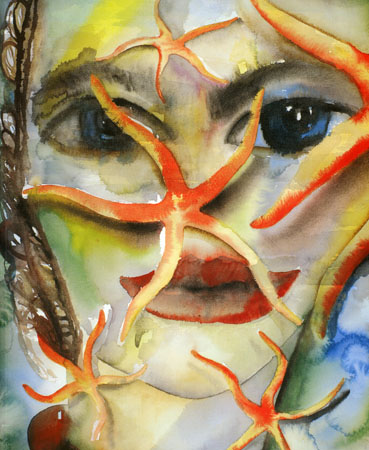

home | books | poetry | plays | translations | online | criticism | video | collaboration | press | calendar | bio
| Art Books and Catalogues | Curatorial | Poetry | Translation |
 |
|||
| Francesco Clemente: New Works, 2004, Irish Museum of Modern Art, Dublin / Reykjavik Art Museum, Kjarvalsstadir | |||
The Hidden Mystic: Recent Paintings by Francesco Clementeby Vincent Katz After his Guggenheim retrospective in late 1999, Francesco Clemente might have been expected either to lapse into repetitions of past glories or to go through an artistic breakdown. The exhibition, in its grandiosity and inclusiveness, had the feeling of a timely and carefully orchestrated sweep through history. Much of this had to do with the attention Clemente and his friend Bill Katz invested in the display of objects in the museum’s notoriously malicious spaces. After that momentous occasion, Clemente has, almost miraculously, found ways to sail ahead to different waters. His paintings since 2000 show him developing a fresh, and somewhat colder, body of work. Clemente’s way of working ensures that he will renew his corpus. He keeps notebooks, in which he amasses sketches as well as copious notes. These are ideas, from which he may draw, but not in a direct way, as a study is used to compose a finished piece. Whether working in pastel, watercolour, or oil on canvas, he begins quickly, letting his hand lead the way. A form or idea will lead to a shape before he can rationalise what that image will become. Once it has taken its place, he can refine or develop it in a more conscious way. Another element that guides Clemente’s art is his choice of medium. He made an early decision to master fresco, encaustic, oil painting on wood, in addition to those techniques already named. He was encouraged to pursue drawing by his admiration of the drawings of Joseph Beuys, an interesting intersection, as the rest of Beuys’ work depends on a denial of traditional techniques, whereas Clemente’s depends on pursuit of them. Clemente considers film and photography a ‘cult of death’, a contrarian stance in the current moment. He also makes a point of connecting strongly with past artistic traditions – whether they be Neapolitan fresco, Fayum coffin portraits, or Orissa temple sculpture. In the 1970s, Clemente established himself as both a follower of Modernists Warhol and Beuys and as an opponent of the Modernist dogma that demanded a separation of the contemporary from what had gone before. There is, in some of Clemente’s recent paintings, a pre-occupation with interlocking forms, an almost gridlike display of pleasure and pain as shared elements of the same experience, shared throughout humanity. One recent painting contains an array of connected sleeping figures; others are more violent – bodies missing heads or limbs, eyes punctured by spikes. Clemente has always been keenly aware of the political uses to which people are put; his work contains outrage at those misuses, but it refuses to engage in a direct way. The artist speaks of a meditative stillness, which is not indifference, but a belief that all things, all beings, are connected, that distinctions between inside and outside, us and them, are arbitrary and imposed. One of his first strategies was to use the human body – the self-portrait in particular – as a site for painterly and philosophical experimentation. This led to a series of studies of the problem not so much of figure and ground as inner and outer. He pursued a vision in which things were constantly, and often disturbingly, flowing into and out of the body. In his more recent work, the stillness has gotten colder. He has done a series of paintings on the theme of Vanitas, and pain seems more prevalent than pleasure. In 2000, the first post-retrospective work Clemente produced resulted in a diverse group of Vanitas pieces – for one series he used a fresco technique that included hot wax, for another oil on canvas. Clemente arrived at the imagery without direct reference to previous models. Although his knowledge of visual art and literature is wide-ranging, he keeps it in the background, preferring to allow images and ideas to arise in unpredictable ways – sometimes as a chaotic dreamlike mélange of figures and entities, as in his seminal Stations of the Cross paintings from 1982, other times, as now, more pared down and cooler. The Vanitas tradition is a long one. In poetry, one can find precursors in the seventh-century BC poetry of Mimnermos of Smyrna, who wrote: Immediately unspeakable sweat pours down my flesh Mimnermos No. 5; M.L. West, Iambi et Elegi Graeci Ante Alexandrum Cantati, Oxford, 1972, Vol. 2; translation by Vincent Katz In Isshu Miura and Ruth Fuller Sasaki, The Zen Koan: Its History and Use in Rinzai Zen, San Diego, 1965, pp. 5 - 7 Quotes of Francesco Clemente, unless otherwise noted, are from a conversation with the author on 25 November 2003. Francesco Clemente in View, Vol. III, No. 6, Nov. 1981, Francesco Clemente issue, interview by Robin White at Crown Point Press, Oakland, California, 1981 Francesco Clemente, ‘The City and The Painter,’ in Alex Katz, Seven Paintings, Exhibition Catalogue, Jablonka Galerie, Cologne, 1997 Jeffrey J. Kripal, Roads of Excess, Palaces of Wisdom: Eroticism and Reflexivity in the Study of Mysticism, Chicago, 2001, p. xii |
|||